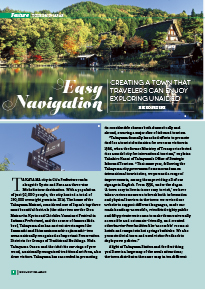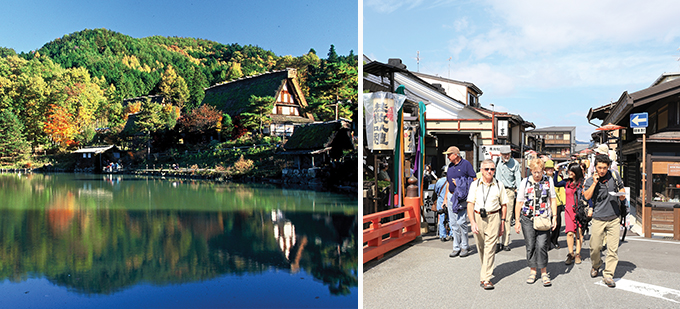Home > Highlighting JAPAN >Highlighting Japan April 2015>Tourism in Japan
Highlighting JAPAN

Tourism in Japan
Easy Navigation
Creating a town that travelers can enjoy exploring unaided

Takayama city in Gifu Prefecture ranks alongside Kyoto and Nara as a three-star Michelin tour destination. With a population of just 92,000 people, the city hosted a total of 280,000 overnight guests in 2014. The home of the Takayama Matsuri, considered one of Japan’s top three most beautiful festivals (the other two are the Gion Matsuri in Kyoto and Chichibu Yomatsuri Festival in Saitama Prefecture), and the source of famous Hida beef, Takayama also has ancient streetscapes like Sanmachi and Shimominomachi-oojinmachi—two areas nationally recognized as Important Preservation Districts for Groups of Traditional Buildings. Hida Takayama Onsen and the ichii itto carvings of yew wood, a nationally recognized traditional art form, also draw visitors. Takayama has succeeded in promoting its considerable charms both domestically and abroad, securing a major slice of inbound tourism.
“Takayama formally launched efforts to promote itself as a tourist destination for overseas visitors in 1986, when the former Ministry of Transport selected it as a model city for international tourism,” explains Takahiro Kuzui of Takayama’s Office of Strategic Inbound Tourism. “That same year, following the Takayama city government’s memorandum on international tourist sites, we pursued a range of improvements, among them providing all of our signage in English. From 1996, under the slogan ‘A town easy to live in is one easy to visit,’ we have taken various measures to break both information and physical barriers in the town: we revised our website to support different languages, made our roads handicap-accessible, retrofitted eighty public and fifty private restrooms to make them universally accessible and ostomate-friendly, and created other barrier-free facilities like ‘accessible’ rooms at hotels and ramps into hot springs bathtubs. We also promoted trial tours and used visitor feedback to deploy new policies.”
Alight at Takayama Station and the first thing you’ll see is a large map of the area’s attractions; the town distributes the same map in ten different languages. All maps the town uses have the same scale, making them easy to follow. English-language interpreters are permanently installed at the Visit Japan Information Booth, and there are 40 signposts available in Japanese, English, Chinese (both traditional and simplified) and Korean, as well as 260 roadside signs in Japanese and English installed around the town. Hida Minzoku Mura Folk Village also offers public Wi-Fi that can be used free for a week.
“Since the ‘Visit Japan’ campaign the Ministry of Land, Infrastructure, Transport and Tourism began in 2003, the number of visitors to Japan started rising, and visitors to Takayama increased steadily as well,” Kuzui says. “However, we didn’t want to take a passive stance on this, so we’ve revised our website and created pamphlets outlining the support offered at accommodations and restaurants. We also hold training events, distribute DVDs and pamphlets about Takayama in six languages, and exhibit at tourism fairs overseas. Our effort and proactiveness allowed us to go from 50,000 visitors in 2003 to 280,000 last year.”
Such initiatives are not limited to Takayama’s government, either. The private sector is also working hard to lure overseas visitors: local tourism associations and hotel groups collaborate with the city through the Hida Takayama International Tourism Promotion Convention, hunting for effective ways to promote the city overseas and heighten its consciousness as a tourist site, as well as making an effort to share such awareness.
Today Takayama Station has numerous visitors from abroad. Here amid this rustic townscape, irrigation ditches stream beneath the eaves filled with rows of latticed bay windows, the curtains of old established shops are set out, and sake brewers hang their sakabayashi—large ornamental balls made of Japanese cedar twigs. While walking among these streets filled with the atmosphere of traditional Japan, you will frequently cross paths with foreign tourists. And you can sense that they are able to fully enjoy their sight-seeing because they can utilize multilingual support. With more and more travelers coming to Japan each year, Takayama is in a favorable position to continue its growth as a town that foreign visitors can enjoy exploring on their own.
© 2009 Cabinet Office, Government of Japan






